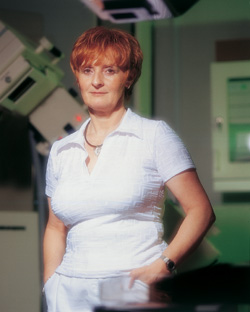Case Studies
Dr. Krisztina Nahm Teleradiologist Uses RadiForce RX850 for Mammography
Products Deployed
RadiForce RX850
Dr. Krisztina Nahm

Dr. Krisztina Nahm earned her degree at the Semmelweis University, Budapest in 1978 and became a mammography radiologist in 1982. She has been a leading member of the mammography division of the Hungarian Society of Radiologists since its inception and is one of the most acknowledged specialists in Hungary.
Teleradiology is Spreading Fast
Teleradiology is becoming increasingly popular in Hungary due to a general shortage of experienced radiologists in the country. Moreover, working from home or from a private practice gives more flexiblity for radiologists in terms of time management and job diversity as they can work for multiple larger clinics and universities at the same time.
Technical Challenges
Modern information technology allows fast and safe transmission of patient data and images over the Internet. However, numerous technical challenges can arise when the radiologist does not work physically within the hospital’s local area network. As Dr. Nahm is currently in contractual agreement with four different hospitals (one in the countryside and three in the capital, Budapest) the network bandwidth and the safe patient data transmission to these healthcare institutions have become an issue for her. Four separate VPN connections have been installed to each hospital from one single workstation, by which Dr. Nahm is able to communicate confidentially with each institution from her private practice.
When physically working at different locations it is also important to simulate the environment that one would find in a hospital’s dark reading room. In order to meet international standards and to ensure the reliability of the diagnosis, teleradiologists need to take care of several factors at their place of work such as room illuminance, light reflection from the monitor, temperature settings and work ergonomy.
Choice of RadiForce RX850
“For me, EIZO medical monitors have been synonimous with premium features and cutting edge technology,” says Dr. Nahm. “I like the idea that, unlike on a conventional twin-monitor setup, I have now one single workspace without the annoying central frame. On the spacious 32” screen my viewing time is shortened and thus reading efficiency is improved. Moreover, the color displaying capabilities of this monitor allow me to diagnose images of different modalities as well.
“The ergonomic features and well-thought design of the RX850 saves space on my desktop and makes staring at the display for an extended period of time much less tiring” comments Dr. Nahm. “Contract-based teleradiologists often choose lower quality monitors because of cost considerations, but with my RX850 I am now assured that I am using the latest available technology from which both doctor and patient can benefit the most.”

